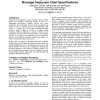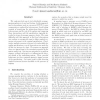6 search results - page 1 / 2 » Unexpected behaviour of crossing sequences |
ENDM
2008
13 years 4 months ago
2008
The nth crossing number of a graph G, denoted crn(G), is the minimum number of crossings in a drawing of G on an orientable surface of genus n. We prove that for every a > b &g...
IJBIDM
2011
12 years 11 months ago
2011
: Web usage mining has been much concentrated on the discovery of relevant user behaviours from Web access record data. In this paper, we present WebUser, an approach to discover u...
SIGSOFT
2001
ACM
14 years 5 months ago
2001
ACM
Scenario-based specifications such as Message Sequence Charts (MSCs) are becoming increasingly popular as part of a requirements specification. Scenarios describe how system compo...
SEFM
2008
IEEE
13 years 11 months ago
2008
IEEE
The only practical way to test distributed messagepassing systems is to use local testing. In this approach, used in formalisms such as concurrent TTCN-3, some components are repl...
SAB
2010
Springer
13 years 3 months ago
2010
Springer
We introduce a new bee-inspired routing protocol for mobile ad hoc networks. Emphasis is given to the ability of bees to evaluate paths by considering several quality factors. In o...


